Digital Orofacial Identification Technologies in Real-World Scenarios
Abstract
:1. Introduction
2. Materials and Methods
2.1. Sample Selection
2.2. Study Design
2.3. Data Development and Analysis
2.3.1. Data Collection
2.3.2. Visual Comparison
3. Results
3.1. Data Collection
3.2. Visual Comparison
3.2.1. The 3D–3D Superimposition
3.2.2. The 2D-3S Superimposition
4. Discussion
4.1. Data Collection
4.2. Superimposition Issues
5. Conclusions
Supplementary Materials
Author Contributions
Funding
Institutional Review Board Statement
Informed Consent Statement
Data Availability Statement
Acknowledgments
Conflicts of Interest
References
- American Board of Forensic Odontology (ABFO). ABFO Standards and Guidelines for Dental Age Assessment. 2021. Available online: https://abfo.org/ (accessed on 1 May 2023).
- Interpol. Disaster Victim Identification Guide. Annexure 4. Phase 2 2023:48. Available online: https://www.interpol.int/en/content/download/589/file/18Y1344%20E%20DVI_Guide.pdf (accessed on 5 December 2023).
- Dostalova, T.; Eliasova, H.; Seydlova, M.; Broucek, J.; Vavrickova, L. The application of CamScan 2 in forensic dentistry. J. Forensic Leg. Med. 2012, 19, 373–380. [Google Scholar] [CrossRef] [PubMed]
- Putrino, A.; Bruti, V.; Enrico, M.; Costantino, C.; Ersilia, B.; Gabriella, G. Intraoral Scanners in Personal Identification of Corpses: Usefulness and Reliability of 3D Technologies in Modern Forensic Dentistry. Open Dent. J. 2020, 14, 255–266. [Google Scholar] [CrossRef]
- Bae, E.-J.; Woo, E.-J. Quantitative and qualitative evaluation on the accuracy of three intraoral scanners for human identification in forensic odontology. Anat. Cell Biol. 2022, 55, 72–78. [Google Scholar] [CrossRef] [PubMed]
- Santo, E.; Pinho, T.; Teixeira, A.; Perez-Mongiovi, D. Use of intraoral three-dimensional images for the identification of dental morphological traits related to ancestry estimation. J. Forensic Sci. Med. 2021, 7, 70. [Google Scholar] [CrossRef]
- Caplova, Z.; Obertova, Z.; Gibelli, D.M.; De Angelis, D.; Mazzarelli, D.; Sforza, C.; Cattaneo, C. Personal Identification of Deceased Persons: An Overview of the Current Methods Based on Physical Appearance. J. Forensic Sci. 2018, 63, 662–671. [Google Scholar] [CrossRef] [PubMed]
- Abduo, J.; Bennamoun, M. Three-dimensional image registration as a tool for forensic odontology: A preliminary investigation. Am. J. Forensic Med. Pathol. 2013, 34, 260–266. [Google Scholar] [CrossRef] [PubMed]
- Nakamura, Y.; Nakamura, M.; Kasahara, N.; Hashimoto, M. Personal Identification by Superimposition of Three-dimensional Intraoral Models. Bull. Tokyo Dent. Coll. 2020, 61, 169–178. [Google Scholar] [CrossRef] [PubMed]
- Mesejo, P.; Martos, R.; Ibáñez, Ó.; Novo, J.; Ortega, M. A Survey on Artificial Intelligence Techniques for Biomedical Image Analysis in Skeleton-Based Forensic Human Identification. Appl. Sci. 2020, 10, 4703. [Google Scholar] [CrossRef]
- Simon, B.; Aschheim, K.; Vág, J. The discriminative potential of palatal geometric analysis for sex discrimination and human identification. J. Forensic Sci. 2022, 67, 2334–2342. [Google Scholar] [CrossRef] [PubMed]
- Zhao, J.; Du, S.; Liu, Y.; Saif, B.S.; Hou, Y.; Guo, Y. Evaluation of the stability of the palatal rugae using the three-dimensional superimposition technique following orthodontic treatment. J. Dent. 2022, 119, 104055. [Google Scholar] [CrossRef]
- Reesu, G.V.; Mânica, S.; Revie, G.F.; Brown, N.L.; Mossey, P.A. Forensic dental identification using two-dimensional photographs of a smile and three-dimensional dental models: A 2D-3D superimposition method. Forensic Sci. Int. 2020, 313, 110361. [Google Scholar] [CrossRef]
- Roy, J.; Shahu, U.; Shirpure, P.; Soni, S.; Parekh, U.; Johnson, A. A literature review on dental autopsy an invaluable investigative technique in forensics. Autops. Case Rep. 2021, 11, e2021295. [Google Scholar] [CrossRef] [PubMed]
- Franco, A.; Willems, G.; Souza, P.H.C.; Bekkering, G.E.; Thevissen, P. The uniqueness of the human dentition as forensic evidence: A systematic review on the technological methodology. Int. J. Leg. Med. 2015, 129, 1277–1283. [Google Scholar] [CrossRef]
- Gibelli, D.; De Angelis, D.; Pucciarelli, V.; Riboli, F.; Ferrario, V.F.; Dolci, C.; Sforza, C.; Cattaneo, C. Application of 3D models of palatal rugae to personal identification: Hints at identification from 3D-3D superimposition techniques. Int. J. Leg. Med. 2018, 132, 1241–1245. [Google Scholar] [CrossRef] [PubMed]
- Stucki, S.; Gkantidis, N. Assessment of techniques used for superimposition of maxillary and mandibular 3D surface models to evaluate tooth movement: A systematic review. Eur. J. Orthod. 2020, 42, 559–570. [Google Scholar] [CrossRef] [PubMed]
- Róth, I.; Czigola, A.; Joós-Kovács, G.L.; Dalos, M.; Hermann, P.; Borbély, J. Learning curve of digital intraoral scanning—An in vivo study. BMC Oral Health 2020, 20, 287. [Google Scholar] [CrossRef] [PubMed]
- Róth, I.; Czigola, A.; Fehér, D.; Vitai, V.; Joós-Kovács, G.L.; Hermann, P.; Borbély, J.; Vecsei, B. Digital intraoral scanner devices: A validation study based on common evaluation criteria. BMC Oral Health 2022, 22, 140. [Google Scholar] [CrossRef] [PubMed]
- Mangano, F.; Gandolfi, A.; Luongo, G.; Logozzo, S. Intraoral scanners in dentistry: A review of the current literature. BMC Oral Health 2017, 17, 149. [Google Scholar] [CrossRef] [PubMed]
- Vilborn, P.; Bernitz, H. A systematic review of 3D scanners and computer assisted analyzes of bite marks: Searching for improved analysis methods during the Covid-19 pandemic. Int. J. Leg. Med. 2022, 136, 209–217. [Google Scholar] [CrossRef] [PubMed]
- Talaat, S.; Kaboudan, A.; Bourauel, C.; Ragy, N.; Kula, K.; Ghoneima, A. Validity and reliability of three-dimensional palatal superimposition of digital dental models. Eur. J. Orthod. 2017, 39, 365–370. [Google Scholar] [CrossRef] [PubMed]
- Molina, A.; Martin-de-las-Heras, S. Accuracy of 3D scanners in tooth mark analysis. J. Forensic Sci. 2015, 60 (Suppl. S1), S222–S226. [Google Scholar] [CrossRef] [PubMed]
- Cortes, A.R. Artificial Intelligence in Planning Oral Rehabilitations: The current status of the field is as follows. Appl. Sci. 2024, 14, 4093. [Google Scholar] [CrossRef]
- Arnett, G.W.; Jelic, J.S.; Kim, J.; Cummings, D.R.; Beress, A.; Worley, C.M., Jr.; Chung, B.; Bergman, R. Soft tissue cephalometric analysis: Diagnosis and treatment planning of dentofacial deformity. Am. J. Orthod. Dentofac. Orthop. 1999, 116, 239–253. [Google Scholar] [CrossRef] [PubMed]
- Reesu, G.V.; Brown, N.L. Application of 3D imaging and selfies in forensic dental identification. J. Forensic Leg. Med. 2022, 89, 102354. [Google Scholar] [CrossRef] [PubMed]
- Corte-Real, A.; Silva, D.N.; Corte-Real, F.; Anjos, M.J. Bitemarks in foodstuffs—An approach for genetic identification of the bitter. Forensic Sci. Int. Genet. Suppl. Ser. 2013, 4, e340-1. [Google Scholar] [CrossRef]
- Gibelli, D.; Palamenghi, A.; Poppa, P.; Sforza, C.; Cattaneo, C.; De Angelis, D. 3D-3D facial registration method applied to personal identification: Does it work with limited portions of faces? An experiment in ideal conditions. J. Forensic Sci. 2022, 67, 1708–1714. [Google Scholar] [CrossRef] [PubMed]
- Gibelli, D.; De Angelis, D.; Poppa, P.; Sforza, C.; Cattaneo, C. A View to the Future: A Novel Approach for 3D-3D Superimposition and Quantification of Differences for Identification from Next-Generation Video Surveillance Systems. J. Forensic Sci. 2017, 62, 457–461. [Google Scholar] [CrossRef] [PubMed]
- Soto-Álvarez, C.; Fonseca, G.M.; Viciano, J.; Alemán, I.; Rojas-Torres, J.; Zúñiga, M.H.; López-Lázaro, S. Reliability, reproducibility and validity of the conventional buccolingual and mesiodistal measurements on 3D dental digital models obtained from intra-oral 3D scanner. Arch. Oral Biol. 2020, 109, 104575. [Google Scholar] [CrossRef] [PubMed]
- Gibelli, D.M.; Cappella, A.; Dolci, C.; Rosati, R.; Bedoni, M.; Sforza, C. A Longitudinal 3D Investigation on Facial Similarity among Two Monozygotic Twins in Their First Childhood: An Application of the 3D-3D Facial Superimposition Technique. Children 2022, 9, 187. [Google Scholar] [CrossRef]
- Corte-Real, A.; Nunes, T.; Santos, C.; Rupino da Cunha, P. Blockchain technology and universal health coverage: Health data space in global migration. J. Forensic Leg. Med. 2022, 89, 102370. [Google Scholar] [CrossRef]
- Mou, Q.N.; Ji, L.L.; Liu, Y.; Zhou, P.R.; Han, M.Q.; Zhao, J.M.; Cui, W.T.; Chen, T.; Du, S.Y.; Hou, Y.X.; et al. Three-dimensional superimposition of digital models for individual identification. Forensic Sci. Int. 2021, 318, 110597. [Google Scholar] [CrossRef] [PubMed]
- Wilkinson, C.; Lofthouse, A. The use of craniofacial superimposition for disaster victim identification. Forensic Sci. Int. 2015, 252, 187.e1–187.e6. [Google Scholar] [CrossRef]
- Terry, D.A.; Snow, S.R.; McLaren, E.A. Contemporary dental photography: Selection and application. Compend. Contin. Educ. Dent. 2008, 29, 432–436, 438, 440–442 passim; quiz 450, 462. [Google Scholar] [PubMed]
- Corte-Real, A. Orofacial Anatomy Discrepancies and Human Identification—An Education Forensic Approach. Anatomia 2022, 1, 170–176. [Google Scholar] [CrossRef]
- Mazur, M.; Górka, K.; Aguilera, I.A. Smile photograph analysis and its connection with focal length as one of identification methods in forensic anthropology and odontology. For. Sci. Int. 2022, 35, 111285. [Google Scholar] [CrossRef] [PubMed]
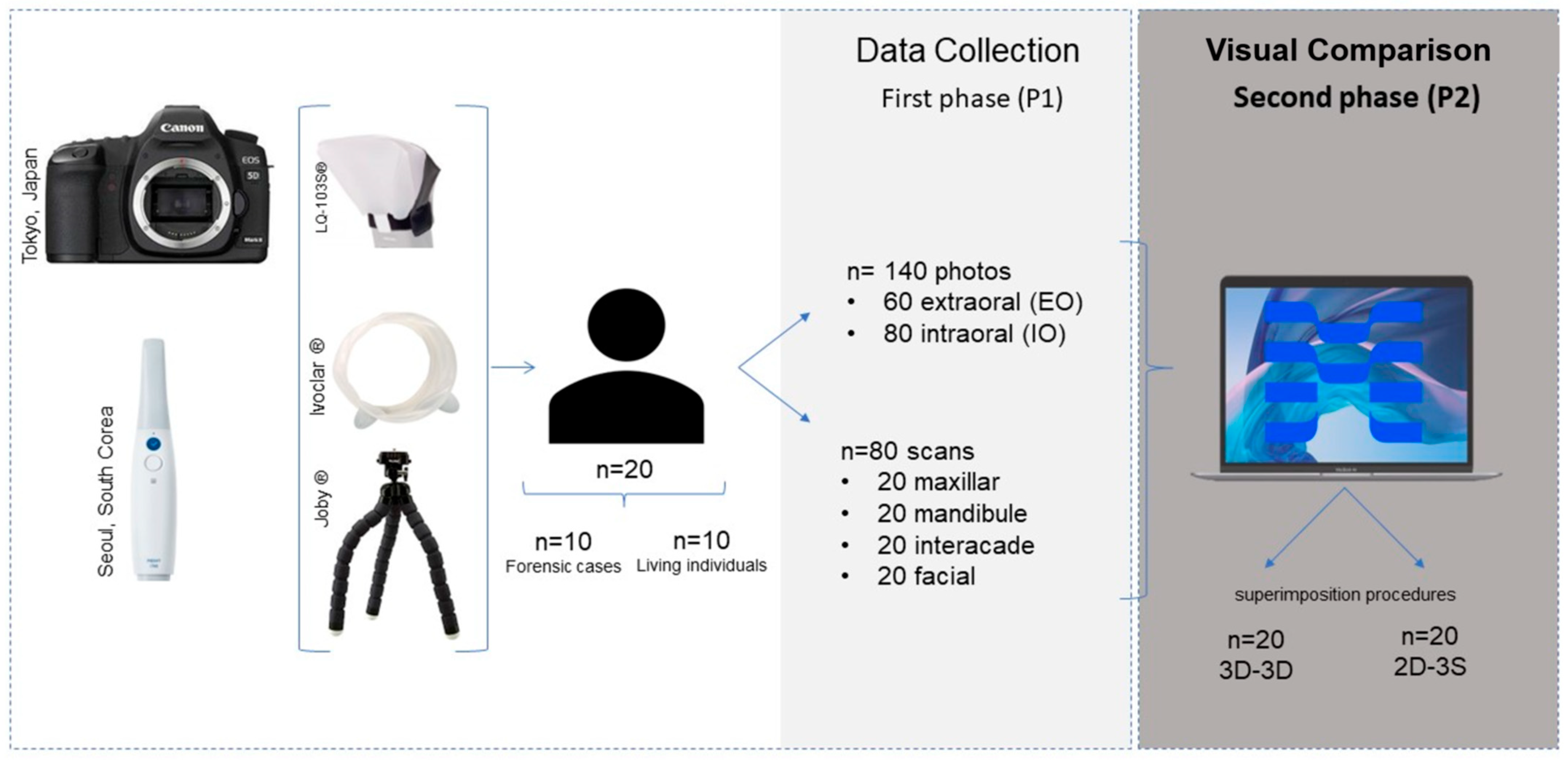
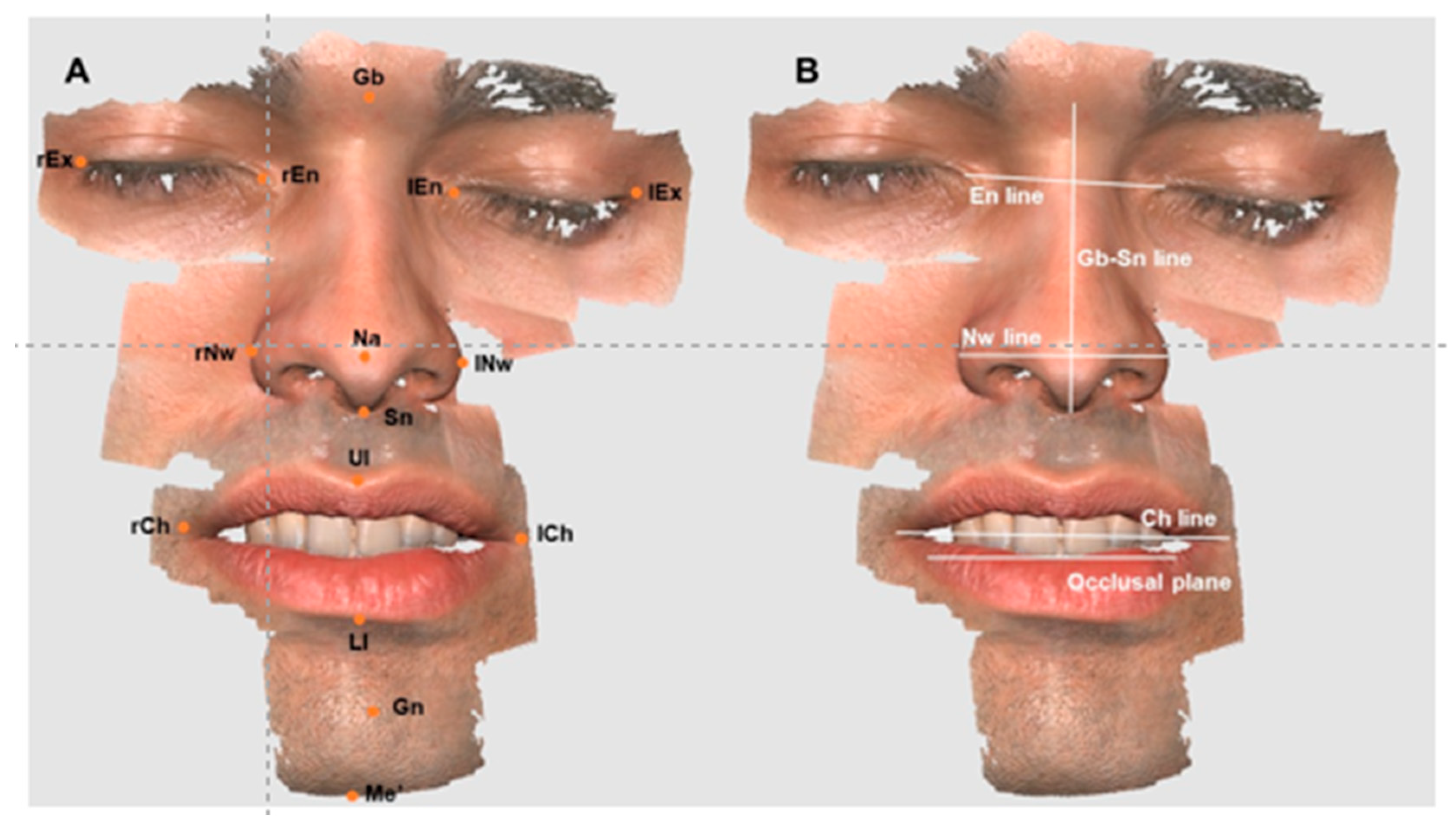

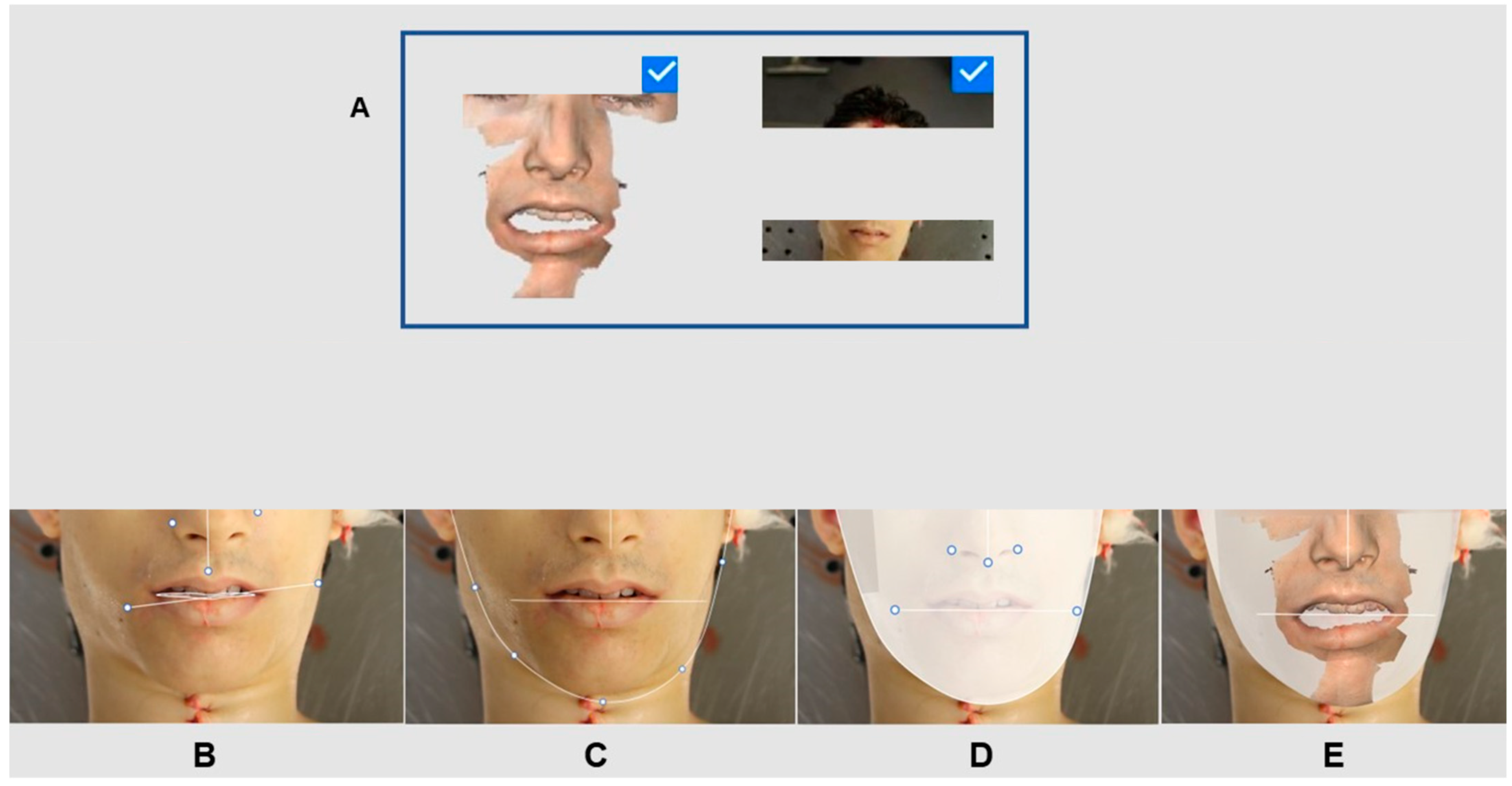

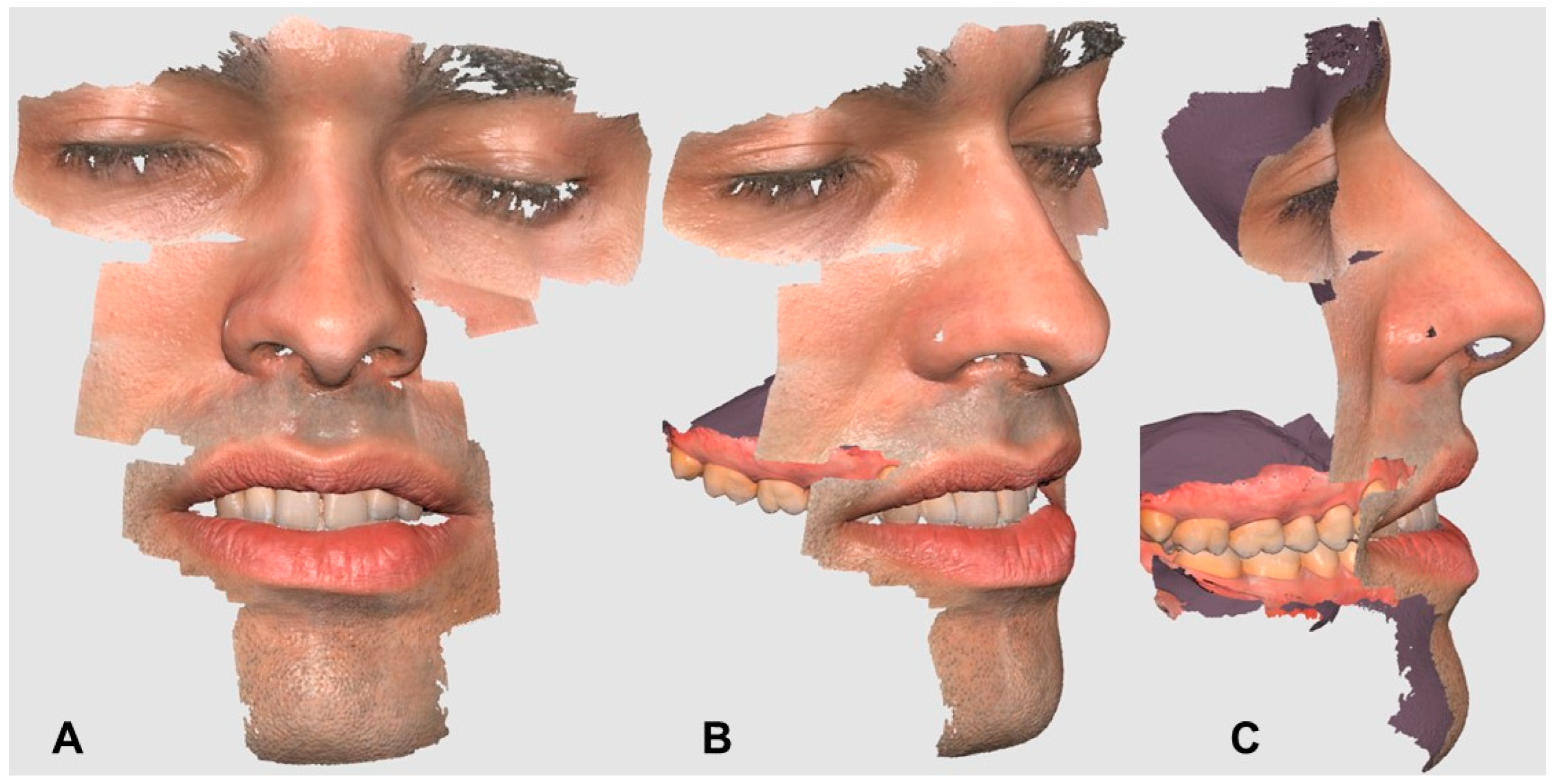
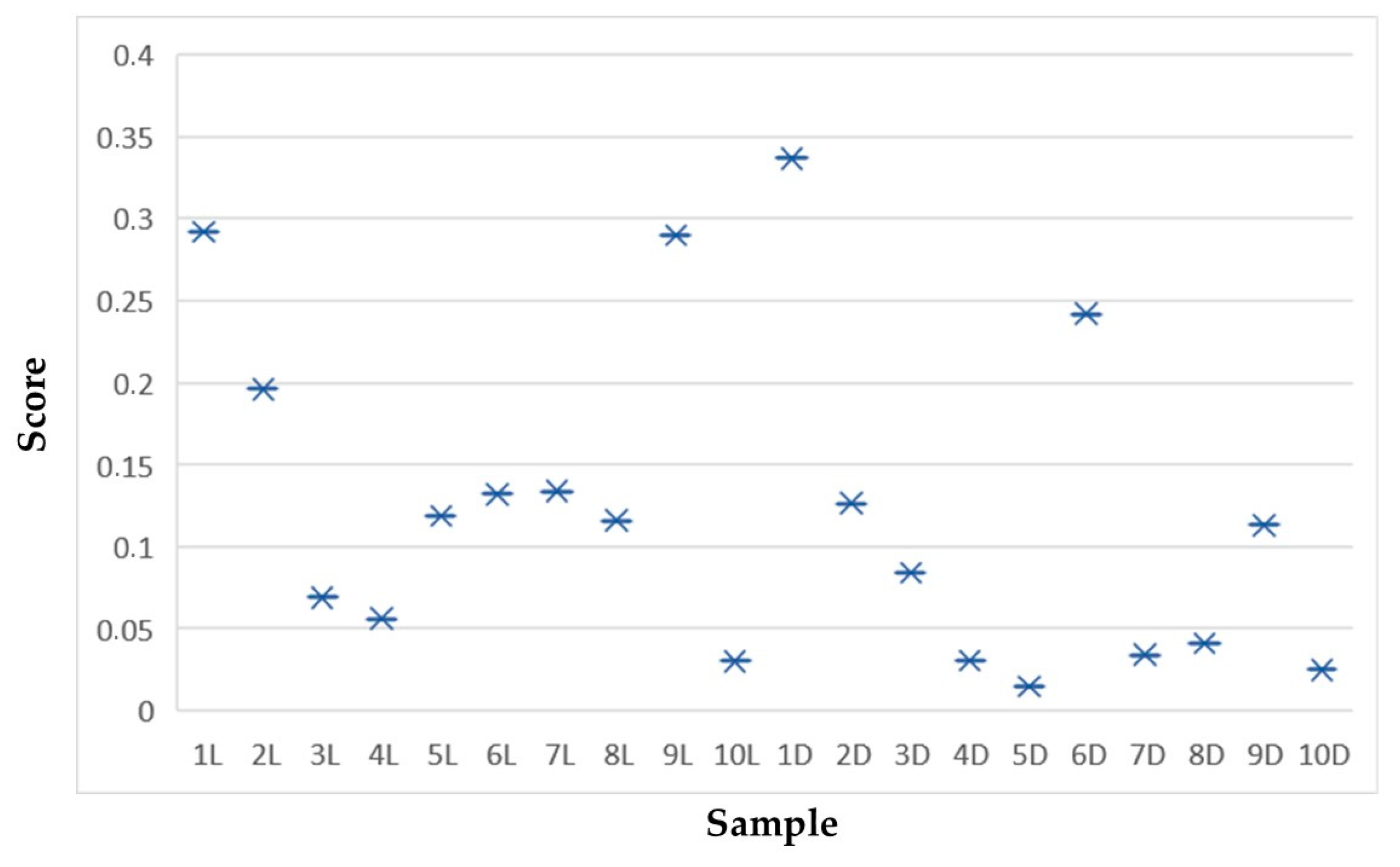
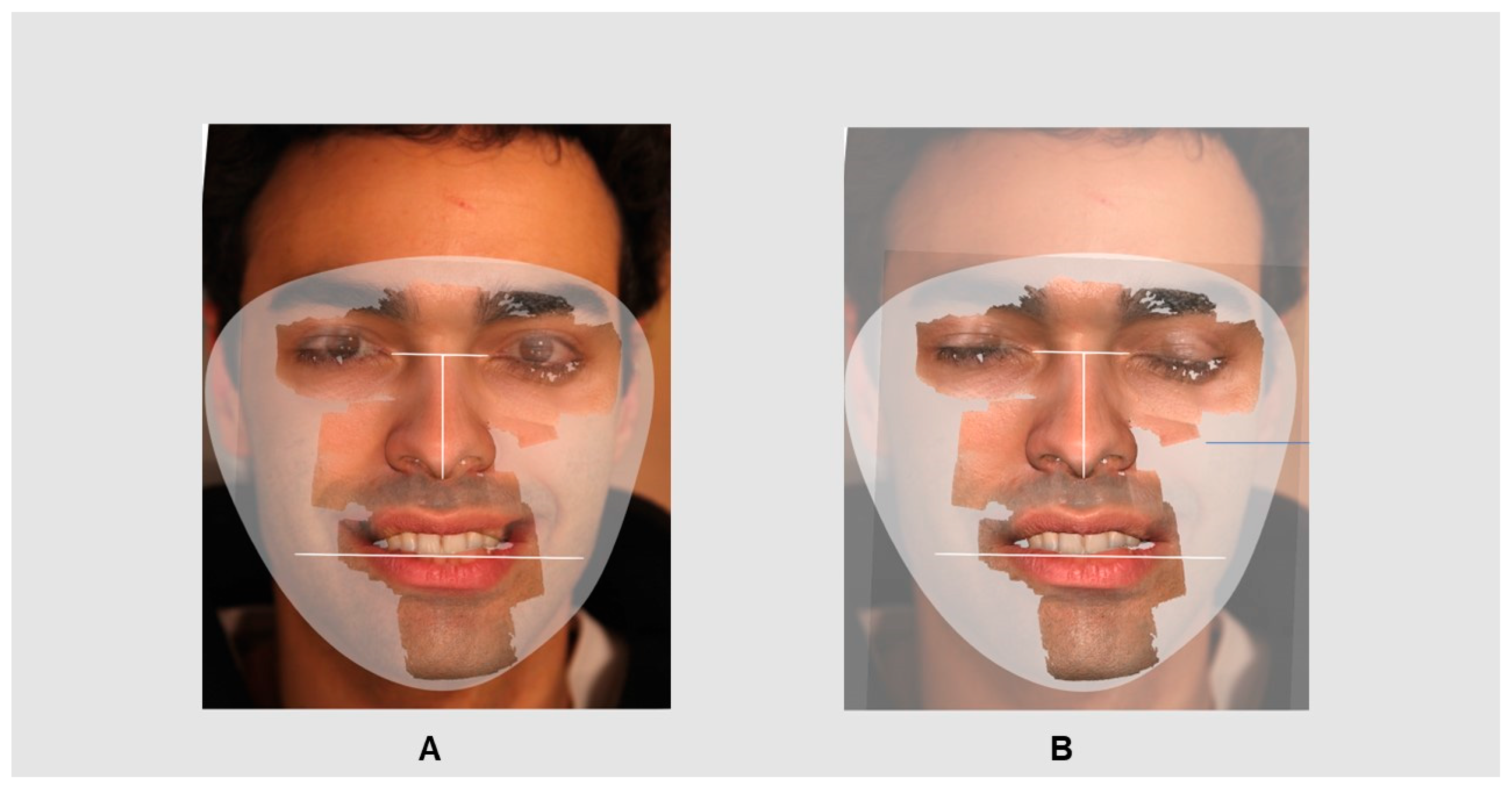
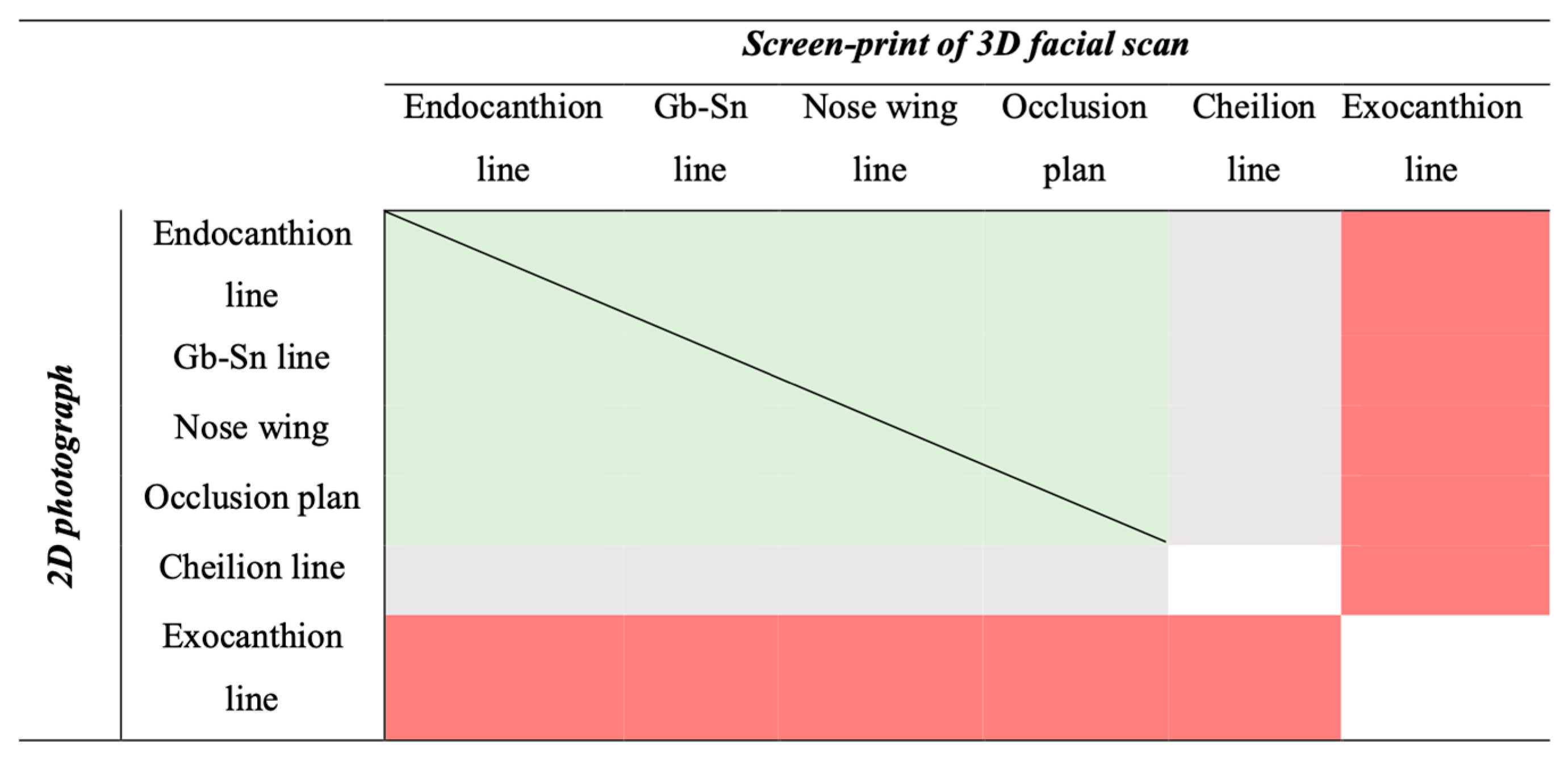
| Parameters | Mean | Std. Deviation | Minimun | Maximum | |||||
|---|---|---|---|---|---|---|---|---|---|
| Life | Death | Life | Death | Life | Death | Life | Death | ||
| Intraoral | Mineralized | 3.70 | 2.40 | 0.46 | 0.49 | 3 | 2 | 4 | 3 |
| Soft | 2.70 | 1.70 | 0.46 | 0.46 | 2 | 1 | 3 | 2 | |
| Communication | 2.00 | 2.00 | 0.00 | 0.00 | 2 | 2 | 2 | 2 | |
| Extra-devices | 1.00 | 1.00 | 0.00 | 0.00 | 1 | 1 | 1 | 1 | |
| Distortion | 3.00 | 1.40 | 0.00 | 0.49 | 3 | 1 | 3 | 2 | |
| Duration | 300.90 | 899.40 | 5.37 | 5.92 | 298 | 889 | 309 | 907 | |
| Extraoral | Soft | 4.00 | 4.00 | 0.00 | 0.00 | 4 | 4 | 4 | 4 |
| Communication | 2.00 | 2.00 | 0.00 | 0.00 | 2 | 2 | 2 | 2 | |
| Extra-devices | 1.00 | 1.00 | 0.00 | 0.00 | 1 | 1 | 1 | 1 | |
| Distortion | 4.00 | 3.20 | 0.00 | 0.40 | 4 | 3 | 4 | 4 | |
| Duration | 89.30 | 301.30 | 1.73 | 3.49 | 86 | 295 | 92 | 308 | |
| Parameters | Mean | Std. Deviation | Minimum | Maximum | |||||
|---|---|---|---|---|---|---|---|---|---|
| Life | Death | Life | Death | Life | Death | Life | Death | ||
| Intraoral | Mineralized | 4.00 | 3.90 | 0.00 | 0.30 | 4 | 3 | 4 | 4 |
| Soft | 4.00 | 3.90 | 0.00 | 0.30 | 4 | 3 | 4 | 4 | |
| Communication | 4.00 | 4.00 | 0.00 | 0.00 | 4 | 4 | 4 | 4 | |
| Extra-devices | 4.00 | 3.00 | 0.00 | 0.00 | 4 | 3 | 4 | 3 | |
| Distortion | 4.00 | 4.00 | 0.00 | 0.00 | 4 | 4 | 4 | 4 | |
| Duration | 720.00 | 788.10 | 11.38 | 8.57 | 709 | 775 | 750 | 800 | |
| Extraoral | Soft | 3.80 | 4.00 | 0.40 | 0.00 | 3 | 4 | 4 | 4 |
| Communication | 4.00 | 4.00 | 0.00 | 0.00 | 4 | 4 | 4 | 4 | |
| Extra-devices | 4.00 | 4.00 | 0.00 | 0.00 | 4 | 4 | 4 | 4 | |
| Distortion | 3.80 | 4.00 | 0.40 | 0.00 | 3 | 4 | 4 | 4 | |
| Duration | 123.70 | 86.10 | 6.29 | 5.96 | 115 | 75 | 135 | 93 | |
Disclaimer/Publisher’s Note: The statements, opinions and data contained in all publications are solely those of the individual author(s) and contributor(s) and not of MDPI and/or the editor(s). MDPI and/or the editor(s) disclaim responsibility for any injury to people or property resulting from any ideas, methods, instructions or products referred to in the content. |
© 2024 by the authors. Licensee MDPI, Basel, Switzerland. This article is an open access article distributed under the terms and conditions of the Creative Commons Attribution (CC BY) license (https://creativecommons.org/licenses/by/4.0/).
Share and Cite
Corte-Real, A.; Ribeiro, R.; Almiro, P.A.; Nunes, T. Digital Orofacial Identification Technologies in Real-World Scenarios. Appl. Sci. 2024, 14, 5892. https://doi.org/10.3390/app14135892
Corte-Real A, Ribeiro R, Almiro PA, Nunes T. Digital Orofacial Identification Technologies in Real-World Scenarios. Applied Sciences. 2024; 14(13):5892. https://doi.org/10.3390/app14135892
Chicago/Turabian StyleCorte-Real, Ana, Rita Ribeiro, Pedro Armelim Almiro, and Tiago Nunes. 2024. "Digital Orofacial Identification Technologies in Real-World Scenarios" Applied Sciences 14, no. 13: 5892. https://doi.org/10.3390/app14135892
APA StyleCorte-Real, A., Ribeiro, R., Almiro, P. A., & Nunes, T. (2024). Digital Orofacial Identification Technologies in Real-World Scenarios. Applied Sciences, 14(13), 5892. https://doi.org/10.3390/app14135892








